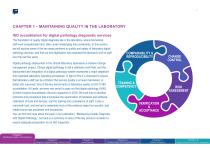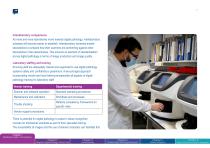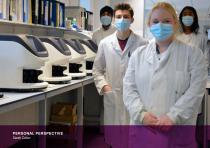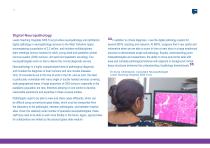 Website:
Leica Biosystems
Website:
Leica Biosystems
Group: Danaher
Catalog excerpts

The Leeds Guide to Digital Pathology Volume 2 Building a National Digital Pathology Network National Pathology Imaging Co-operative
Open the catalog to page 1
INTRODUCTION P3 CHAPTER 1 – MAINTAINING QUALITY IN THE LABORATORY P5 CHAPTER 2 – DIAGNOSTIC DIGITAL PATHOLOGY: CLINICAL USE P13 CHAPTER 3 – HOME REPORTING P21 CHAPTER 4 – MULTISITE DIGITAL PATHOLOGY DEPLOYMENT AND NATIONAL NETWORKS P29 CHAPTER 5 – ARTIFICIAL INTELLIGENCE P37 CHAPTER 6 – PATIENT AND PUBLIC INVOLVEMENT AND ENGAGEMENT P43 FINAL THOUGHTS P47 FURTHER RESO
Open the catalog to page 2
INTRODUCTION It’s hard to believe how the world has transformed in the three years since the team first published “The Leeds Guide to Digital Pathology” in 2018. The COVID-19 pandemic forced everyone, including the pathology community to rise to new challenges. The flexibility and resilience offered by digital pathology have never seemed more important if we want to future-proof our diagnostic services and ensure we can continue to deliver a high-quality histopathology service in a timely manner. At Leeds, we were fortunate to have completed our initial scanner deployment of Aperio AT2...
Open the catalog to page 4
The foundation of quality digital diagnosis lies in the laboratory, where biomedical staff work exceptionally hard, often under challenging time constraints.
Open the catalog to page 5
CHAPTER 1 – MAINTAINING QUALITY IN THE LABORATORY ISO accreditation for digital pathology diagnostic services The foundation of quality digital diagnosis lies in the laboratory, where biomedical staff work exceptionally hard, often under challenging time constraints. In this section, we will explore some of the key areas pertinent to quality and safety of laboratory digital pathology services, and find out how digitisation has impacted the laboratory and its staff over the last five years. Digital pathology deployment in the clinical laboratory represents a massive change management...
Open the catalog to page 6
Key tips 1. e prepared! Careful planning in the earliest stages of your deployment B can help lay the groundwork for successful inspection and accreditation. Identify key personnel who will be instrumental in delivering core aspects of the accreditation procedure, and compiling necessary evidence. 2. evelop and adhere to a full change control procedure. This should D include evidence surrounding the digital deployment proposal, health and safety assessments, validation and verification of equipment, external and internal quality assurance processes, IT user acceptance testing, standard...
Open the catalog to page 7
Quality assurance Daily (Recommended) • Restart the scanner and console (PC) if present • Clean the touchscreen • Clean the scanner cover and light source • Clean the slide trays and carousel/loader • Sections should be free of folds, creases and bubbles. • issue should be placed centrally, within the scannable margins of T the glass slide. • Clean the objective and Koehler • Clear the slide stage tray • Clean the fan filter When Required • Light Source bulb replacement • Schedule annual maintenance visit by vendor The key steps to quality assurance of scanned slides are relatively simple,...
Open the catalog to page 8
Quality control in the laboratory Laboratory quality control is an important step in the histopathology process as it checks that digital slides being signed out of the laboratory are of adequate diagnostic quality. At digital QC the lab are checking for: • overall image quality • gross or focal loss of focus and the reason for this • are there areas of the image out of focus, and the reason Using digital images for the full laboratory quality control pathways Some laboratories check their glass slides for section and staining quality using standard light microscopy before they are sent to...
Open the catalog to page 9
Interlaboratory comparisons As more and more laboratories move towards digital pathology, interlaboratory schemes will become easier to establish. Interlaboratory schemes enable laboratories to compare how their scanners are performing against other laboratories in the network/area. This ensures an element of standardisation across digital pathology in terms of image production and image quality. Laboratory staffing and training Ensuring staff are adequately trained and supported to use digital pathology systems safely and confidently is paramount. A two-pronged approach incorporating...
Open the catalog to page 10
PERSONAL PERSPECTIVE Sarah Caton
Open the catalog to page 11
We’ve seen a lot of change in the laboratory since 2015, evolving from a single scanner installation to running a full clinical service, scanning 100% of our glass slides. We’ve implemented next generation scanners – four Aperio GT 450 DX scanners, which have changed the way we work. We have observed an 85% improvement in scanning efficiency compared with our previous scanners, and we have been able to incorporate digital pathology into other workflows including our autosectioner. One thing I would emphasize, is how important it is to try and keep everyone in the laboratory engaged and...
Open the catalog to page 12
“Digital pathology has improved my turn around time for diagnosis by at least 30 seconds for each slide. It’s very easy and quick to navigate between areas in the same slide and between slides in a case, saving me time and effort navigating through large and complex cases. Dr Azzam Ismail Consultant Neuropathologist Leeds Teaching Hospitals NHS Tr
Open the catalog to page 13
CHAPTER 2 – DIAGNOSTIC DIGITAL PATHOLOGY: CLINICAL USE St James University Hospital, Leeds, UK, is a major NHS cancer centre serving a population of 3 million patients, with a fully subspecialised diagnostic histopathology department. We’ve been integrating digital pathology into our standard clinical workflows over the past 5 years. 100% of histology slides are scanned in the laboratory, and accessible by our consultant and trainee pathologists on medical grade diagnostic workstations. Our first subspecialties to convert to digital microscopy for primary diagnosis were breast and...
Open the catalog to page 14
Digital Neuropathology Leeds Teaching Hospitals NHS Trust provides neuropathology and ophthalmic digital pathology in neuropathology services to the West Yorkshire region, encompassing a population of 2.2 million, and includes multidisciplinary team meetings (tumour boards) for adult, young adult and paediatric central nervous system (CNS) tumours, and adult and paediatric neurology. Two neuropathologists work on site to deliver this crucial diagnostic service. Neuropathology is a highly subspecialized area of pathological diagnosis, and includes the diagnosis of brain tumours and rare...
Open the catalog to page 15All Leica Biosystems catalogs and technical brochures
-
APERIO VERSA
4 Pages
-
Aperio CS2
3 Pages
-
Aperio WebViewer DX User’s Guide
84 Pages
-
Aperio LIS Connectivity Overview
70 Pages
-
Aperio eSlide Manager
100 Pages
-
APERIO CLINICAL SOLUTION
7 Pages
-
APERIO I M AG E A N A LYS I S
20 Pages
-
Leica ASP6025 S
4 Pages
-
Leica VibratomeTM Series
8 Pages
-
Aperio GT 450 DX
5 Pages
-
BOND RXm
4 Pages
-
Leica St4020 Linear Stainer
2 Pages
-
HistoCore SPECTRA ST Stainer
4 Pages
-
Leica CM1520 Cryostat
2 Pages
-
Leica SM2010 R
4 Pages
-
Vibrating Blade Microtomes
8 Pages
-
HistoCore PEARL
4 Pages
-
CEREBRO
8 Pages
-
HistoCore PELORIS 3
3 Pages
-
Leica CM3050 S
4 Pages
-
HistoCore Microtomes
8 Pages
-
Leica ST5010 Autostainer X
8 Pages
-
Leica CM1860/CM1860 UV
5 Pages
-
Aperio eSlide Manager
4 Pages
-
Leica CM1950
12 Pages
-
HistoCore BIOCUT
2 Pages
-
HistoCore Microtomes
4 Pages
-
Stereotaxic Solutions
7 Pages
-
HistoCore PERMA S
4 Pages
-
Leica CM3600 XP
2 Pages
-
Leica RM2125 RTS
2 Pages
-
Leica TP1020
4 Pages
-
Leica ASP300 S
8 Pages
-
Leica IP C
12 Pages
-
Cognitive Cxi
2 Pages













































